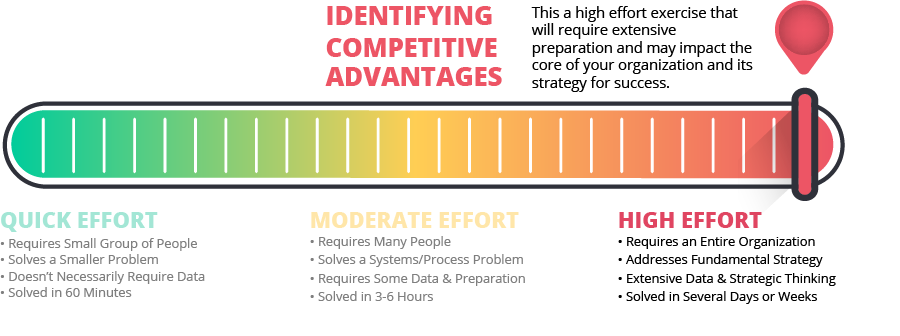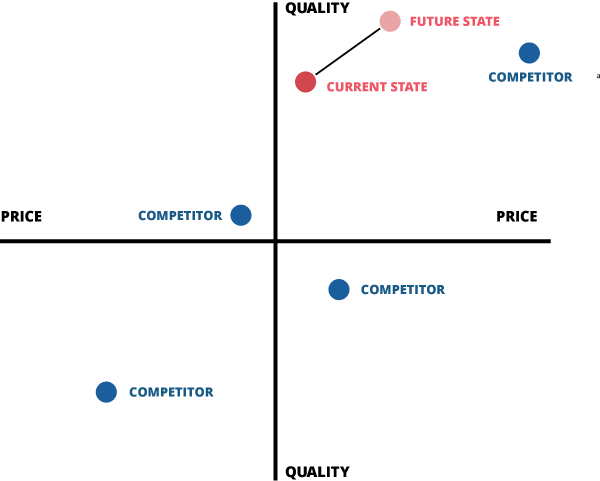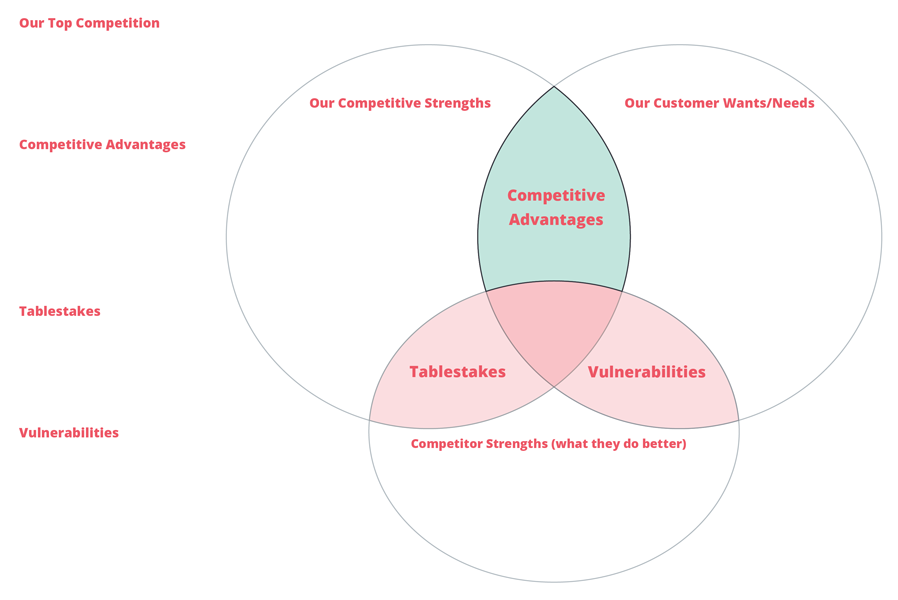In our first two posts in this series, we covered an exercise to solve simple strategic issues and the the GE WorkOut to solve more complex problems in your organization. In this post, we’ll cover an exercise we developed to define your Competitive Advantages and market position. This will be the most advanced of the three within this series.
What is a Competitive Advantage?
A Competitive Advantage is a characteristic of an organization that allows it to meet their customer’s need better than their competition can. It answers the question “What are we best at in our market?” A complete set of Competitive Advantages looks like a list of 2-3 unique strengths that are valued by an organization’s customer.
The Three Traits of True Competitive Advantages
- Competitive Advantages are organizational strengths unique to your organization. These are the strengths that set you apart from your competition. It’s what you do well and is distinctly unique in your market. If your competitors also have this strength, it’s not a Competitive Advantage!
- Competitive Advantages are traits or strengths important to your clients. If the strength you’ve identified is important to you but not important to your client, it’s not a Competitive Advantage. A Competitive Advantage is a strength or reason your clients choose you over your competition. It must have value to your customer!
- Another insightful characteristic of a Competitive Advantage is that it’s hard for your competitors to replicate. It’s not something your competitors could wake up tomorrow and decide is one of their unique strengths. It would take a serious monetary or time investment to replicate.
Get the Free Guide and Canvas to Create a SWOT Analysis
Competitive Advantages Versus Table Stakes
We see this one common mistake again and again in identifying Competitive Advantages – a Competitive Advantage is not a strength you have because your competition also has it. Those strengths, while important to keep you competitive in your market, are often referred to as table stakes. Essentially, they are the required strengths to keep your organization at the table in the marketplace.
Identifying Your Competitive Advantages
OVERVIEW
When to Use: When your organization needs to make critical decisions about your long-term strategic focus.
Why: To clearly outline where your organization will compete in the marketplace and how you’ll see success against your competitors.
Ideal Participants: Your executive team with representation and expertise from all departments within your organization. Ideally, this will be 12-15 individuals.
Time Needed: 1-2 Days (including prep work)

Pre-Session Activities
Identify Your Planning Team
For this session, we recommend assembling a planning team that represents the whole of your organization. This includes your executive team and management from all departments within your organization. This group should be about 12-15 in size and should be comprised of resident experts in various departments.
Prepare Your Data
For this level of problem solving, there will need to be extensive data analysis and preparation prior to your session. Once you’ve selected your team, you’ll need to assign participants.
Synthesize Your SWOT
An important part of this exercise will be examining and ranking your organization’s core strengths. To adequately prepare for this, we recommend having your SWOT (Strengths, Weaknesses, Opportunities, and Threats) analysis complete and clearly synthesized prior to this activity. If you need help completing your organization’s SWOT analysis, check out our How to Perform A SWOT Analysis video.
Complete a Competitor Analysis
Before you can identify your Competitive Advantages, your organization needs to have a good understanding of your competitive landscape and what they offer your customers. We recommend conducting an environmental scan and answering the following:
- Who are your top 4 competitors?
- What does each do well? Where do they fall short?
- What do they do better than you do? What do you do better than them?
- What are their strengths? What are their weaknesses?
- Why do you think customers value them in the marketplace?
Gathering and synthesizing this information is pivotal in the success of this exercise. This could take your planning team several days (or even weeks) to complete prior to your session, so plan accordingly. You could even turn this into a half-day working session if that would better suit your team.
Conduct Customer Interviews
An important step in clearly identifying your Competitive Advantage is understanding what value you provide your customer. There is no better way to understand what a customer values than by asking them. We recommend conducting 3-4 interviews with your ideal customers. The easiest place to start would be with customers you already have a relationship with. Keep these interviews short – about 20-30 minutes. Explore these questions:
- What did you look for when you were shopping for [insert industry/field/product]?
- How do we bring value to your business?
- What other competitors did you look at? What stood out to you?
As you conduct these interviews, take notes. Come back and synthesize this information and be prepared to share this information with the group.
Send the Prepared Materials and Have Your Participants Complete the Pre-Session Questionnaire
Once you have completed the research materials above, send them to your planning team with the following questionnaire. Request that each planning team member come prepared to the meeting with the questionnaire filled out and the materials you’ve attached reviewed prior to the session. The questionnaire includes these questions:
- What are our greatest strengths? List the top four.
- What are our customer’s top four wants and needs?
- In your opinion, what are our top four competitors?
- What do these competitors do better than us? List the top four.
Running the Session
Before you run the session, make sure you have someone who can help re-center the team as they work through these discussion points. As you work through these questions, we recommend taking notes and keeping track of what is articulated during the meeting.
Step One – Define Your Organization’s Greatest Strengths (1 Hour)
During the first hour, discuss what your organization’s greatest strengths are. You are leveraging the work you’ve already completed in the SWOT and your pre-planning activities to come to a consensus as a group what your top 4-5 strengths are as an organization. Use the full hour to discuss and really understand what you do well as an organization.
Step Two – Identify Your Customer’s Top 4 Wants and Needs (1 Hour)
During this time block, we recommend starting off by quickly reviewing the information from your customer interviews. Once you’ve reviewed that information, open the floor for discussion. Again, you’re looking to come to consensus as a group about what your customer’s top 4 wants and needs are from your organization [and your competitors] in the market place.
Step Three – Review Your Competitor Analysis (30 Minutes – 1 Hour)
With the group, review your Competitor Analysis. Everyone should understand who your competitors are, what they offer, and where they play in the marketplace. This could take a varying amount of time depending on your competitive landscape.
Step Four – Rank Your Competitor Strengths (1 Hour)
From your competitive analysis, information from your customer interviews, and the prep-work your team did before the session, identify and rank your core competitors and their strengths. It’s ok if they have some of the same strengths as your organization, but make sure you also identify what strengths they possess that you do not.
Step Five – Complete the Competitive Positioning Map (1 hour)
With your competitor and market analysis fresh, your planning team needs to complete the Competitive Positioning map as follows:
- Determine the x and y axis based on your customer feedback and customer analysis. This will be unique to your organization and market.
- Plot your competitors on the map based on your analysis of their position and strengths.
- Plot your current position.
- Plot your future position.

This exercise allows you to visually see where you stand against your competitors in the marketplace. This exercise will also allow you to visualize your future state in the market place. Completing this will help your planning team answer the question, “where are we going to play?”
Step Six – Complete the Competitive Advantages Map (1 Hour in Session)
With all of the information you’ve gathered, synthesized, and agreed upon, your team can complete the Competitive Advantages Map. An explanation of the different areas of the chart includes:
- Our Competitive Strengths – This is simply the list of your top 4 competitive strengths.
- Our Customer Wants and Needs – This is the list of your top customer wants and needs from earlier.
- Our Competitor Strengths – This is the list of your top competitors and the strengths they bring in the marketplace.
- Table Stakes – These are strengths that you possess that your competitors also possess. These are still strengths, but they are just strengths that allow you to have a seat at the table in the marketplace. These are not Competitive Advantages for you nor your competitors.
- Vulnerabilities – These are strengths your competitors possess that you do not. These competitor strengths represent your vulnerabilities in the marketplace. It’s important to note that these vulnerabilities aren’t something that can be fixed overnight but represent a significant investment to acquire.
- Competitive Advantages – These are your organization’s core strengths that are also valued by your customers. No other competitor also has these strengths, and your customer MUST value them for them to be a true Competitive Advantage.

The culmination of your work will answer the fundamental question, “how are we going to win?” Clearly identifying your competitive edge and leveraging it is at the core of any successful organization.
Step Seven – Complete the Competitive Advantages Map (Beyond the Session)
You’ve completed the hard work. Now, in a smaller group of 2-3 individuals, work on synthesizing your work into a few simple and concise sentences or paragraphs that answer these two foundational questions:
- Where are we going to play? – This should be answered by articulating your current state in the market and where you want to be in the future.
- How are we going to win? – This should be answered by concisely stating your Competitive Advantages.
The answers to these questions should absolutely live within your strategic plan and help your team create long- and short-term priorities to help drive you toward your desired future state. You have a clearly defined competitive edge. Use it!











